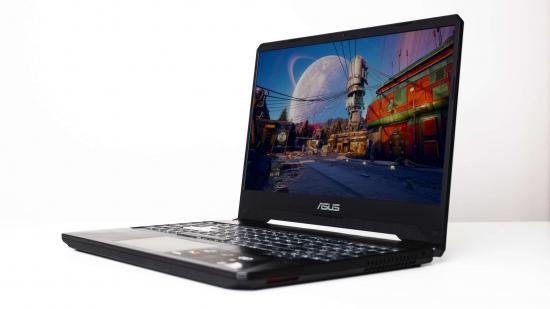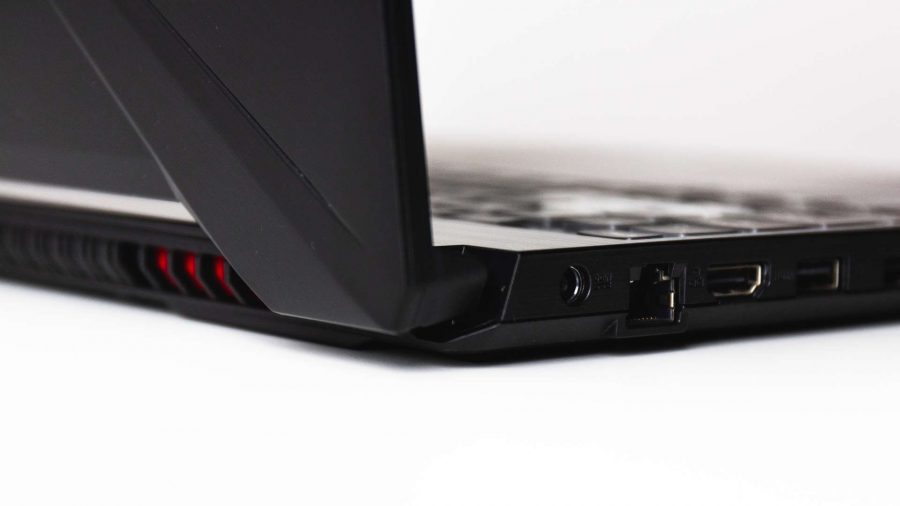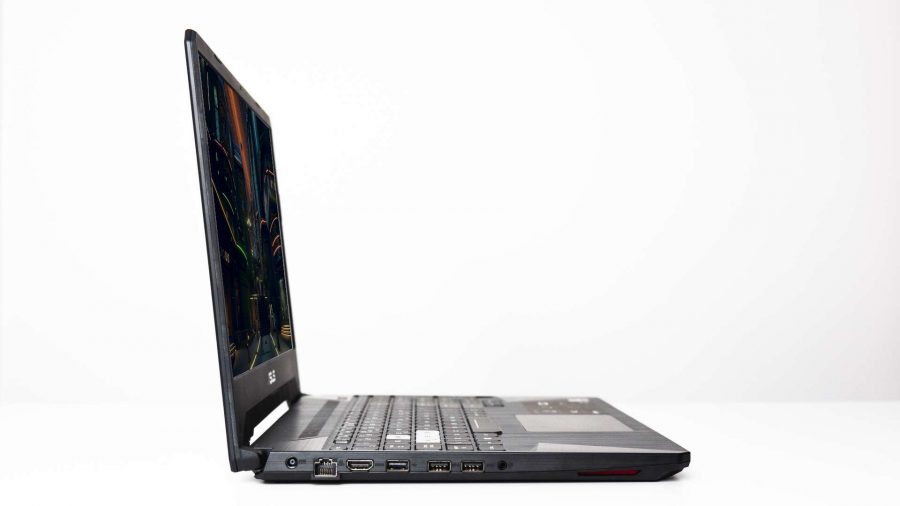Our Verdict
Asus has created an inexpensive gaming laptop that prioritises frame rates while making necessary sacrifices in the right places. But while it’s an affordable notebook, with a 120Hz screen, SSD, and all the RGB you could want, it certainly doesn’t feel cheap.
Gaming laptops are unfeasibly expensive, right? Well, they don’t have to be because Asus’ TUF range includes a seriously good mobile gaming PC that will deliver 1080p gaming for a great price. The combination of Nvidia’s affordable, yet capable, GTX 1650 GPU and AMD’s Ryzen 5 3550H gives the the TUF FX505DT all the tools it needs for gaming performance… and Asus has dropped a few extra luxuries into the mix too.
Inevitably there are compromises here to get the price down to a manageable level, but as with the higher-spec, RTX 2060-powered Asus TUF FX505DV, the cuts have been necessary and generally made in all the right places.
That’s mostly because the two machines are cut from the same cloth. Not that the FX505 is made from cloth, nor is it the sort of unibody aluminium shell super high-end gaming notebooks are encased in. But, while it may be housed in a modestly chunky plastic chassis, it doesn’t really feel like a budget machine, and that’s because Asus has left in a few gamer flourishes here and there.
But let’s start with the innards. The AMD Ryzen 5 3550H is the chip at the heart of the TUF FX505DT. That’s essentially a last-gen APU given a Zen+ facelift, and a slight 100MHz clock speed bump. So, sadly this isn’t 7nm silicon of the Ryzen 3rd Gen variety, and we’re looking at both 12nm CPU and GPU components. And yes, that’s a Vega 8 graphics part shouldering the basic rendering demands, not some shiny Navi graphics card.
But it means there’s a low-power GPU for when you’re running on the desktop or throwing any light browser or media loads its way. You don’t need the extra graphical oomph of the Vega 10 chip inside the previous TUF laptop we reviewed, because when you’re gaming the discrete Nvidia graphics card spools up and takes over the heavy graphical lifting.
| Asus TUF FX505DT | |
| CPU | AMD Ryzen 5 3550H |
| GPU | Nvidia GTX 1650 |
| Memory | 8GB DDR4 |
| Storage | 250GB WD Blue SN520 |
| Screen size | 15.6-inch |
| Screen resolution | 1920 x 1080 |
| Refresh rate | 120Hz |
| Price | $879 | £700 |
And, as a general purpose CPU, the Ryzen 5 3550H performs okay; with four cores and eight threads it’s got a fair amount of multi-threaded power to offer in this affordable form. But it does have to be said that the actual single-threaded performance does seem to be a bit off, despite having a solid 3.7GHz Turbo clock speed which comes into play when only one core is needed.
That does affect its overall gaming performance, but considering it’s the graphics card that makes the most difference to your actual frame rates the GTX 1650 is able to keep things trucking along at a decent level.
Expectations may have to be managed to a certain extent, after all the low-spec GTX Turing GPU isn’t going to be smashing ultra settings at 120fps, but it will still deliver quality 1080p gaming if you’re a little more measured in the graphics settings. And if you’re not into doing the heavy-lifting yourself, tweaking and benchmarking to get the best performance, that’s where Nvidia’s GeForce Experience really comes into its own.
In the constrained confines of a gaming laptop GFE’s ability to optimise your game’s settings based on the hardware available, with just one click, is incredibly useful, and means you can get excellent gaming performance without having to spend an age pushing sliders hither and thither and agonising over frame rates.
Even so, at the Asus screen’s native 1080p resolution the GTX 1650 manages decent frame rates even on the top graphics settings, with Far Cry New Dawn hitting 44fps on average and the super-demanding Metro Exodus trucking along at almost 30fps. That’s pretty standard for a lot of gamers in console-land. Poor schmucks.
And that 1080p screen is one of the little gaming luxuries Asus has left in this affordably laptop. The Full HD resolution is welcome for a mainstream GPU, but it’s also sporting a healthy 120Hz refresh rate. That looks fantastic on the desktop, and even if you’re not hitting 120fps the refresh rate still adds a level of silky smoothness to whatever game you throw its way.
You also get RGB LEDs. That’s a gaming luxury, right? What am I talking about… it’s a goddamn gaming necessity. More luxurious is the Western Digital NVMe SSD Asus has used as the boot drive. Unfortunately it’s also the only drive, and at 250GB it’s going to mean a lot of Steam/Epic/Battlenet library management when you want to get your games installed. Try sticking Red Dead Redemption 2 on that and you’ll struggle to get anything else on there.
And it’s not that easy to get inside and perform any sort of storage upgrade to add some cheap data capacity to the system. Getting the back off the machine requires a certain amount of force to remove the panel, and that way lies a damaged plastic chassis.
It’s a similar issue on the memory side too, with Asus opting to only provide a single DIMM for its 8GB system RAM, immediately cutting the laptop’s memory bandwidth in half by restricting it to single channel performance. Realistically that’s not going to hurt your gaming frame rates overmuch, but will hold general system performance back. And again it isn’t easy to upgrade with the way the chassis has been closed up.
But those are all relatively minor niggles, and represent the necessary sacrifices Asus has chosen to make in order to keep costs down and keep gaming performance as high as it possibly can. And with an affordable gaming laptop that’s all you can ask.



